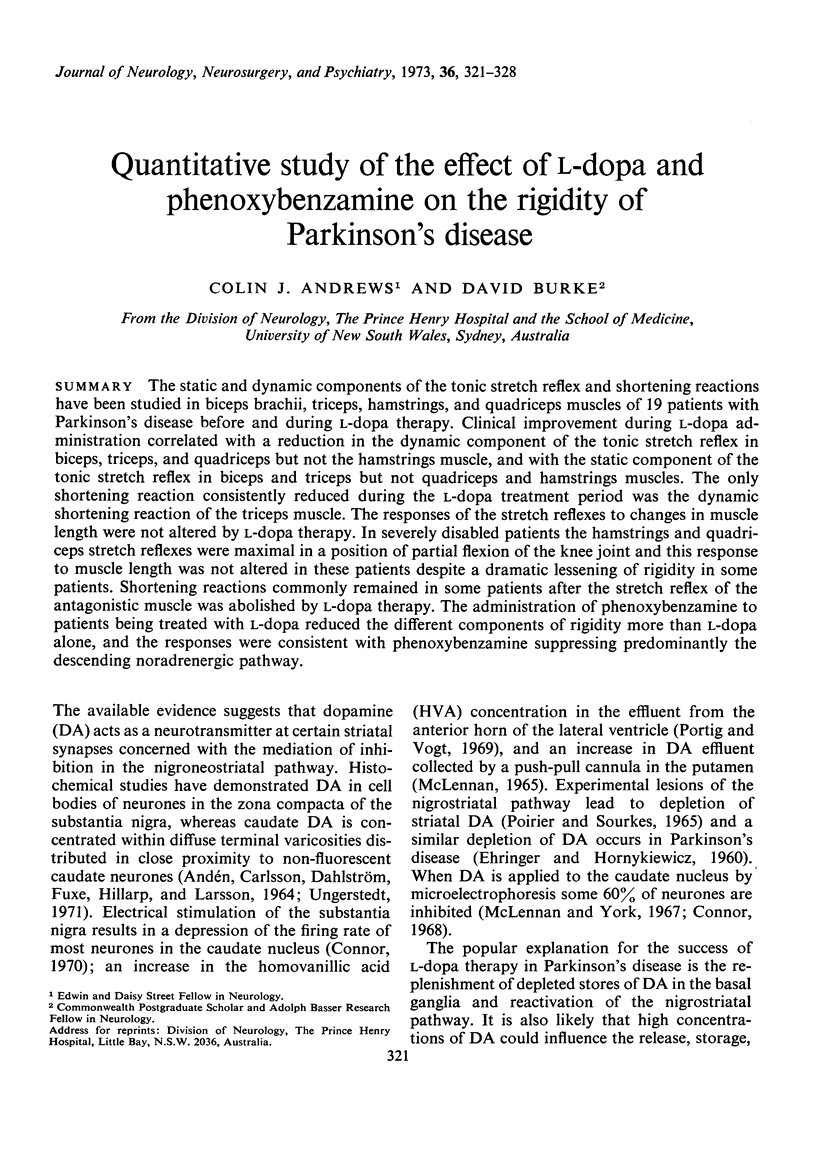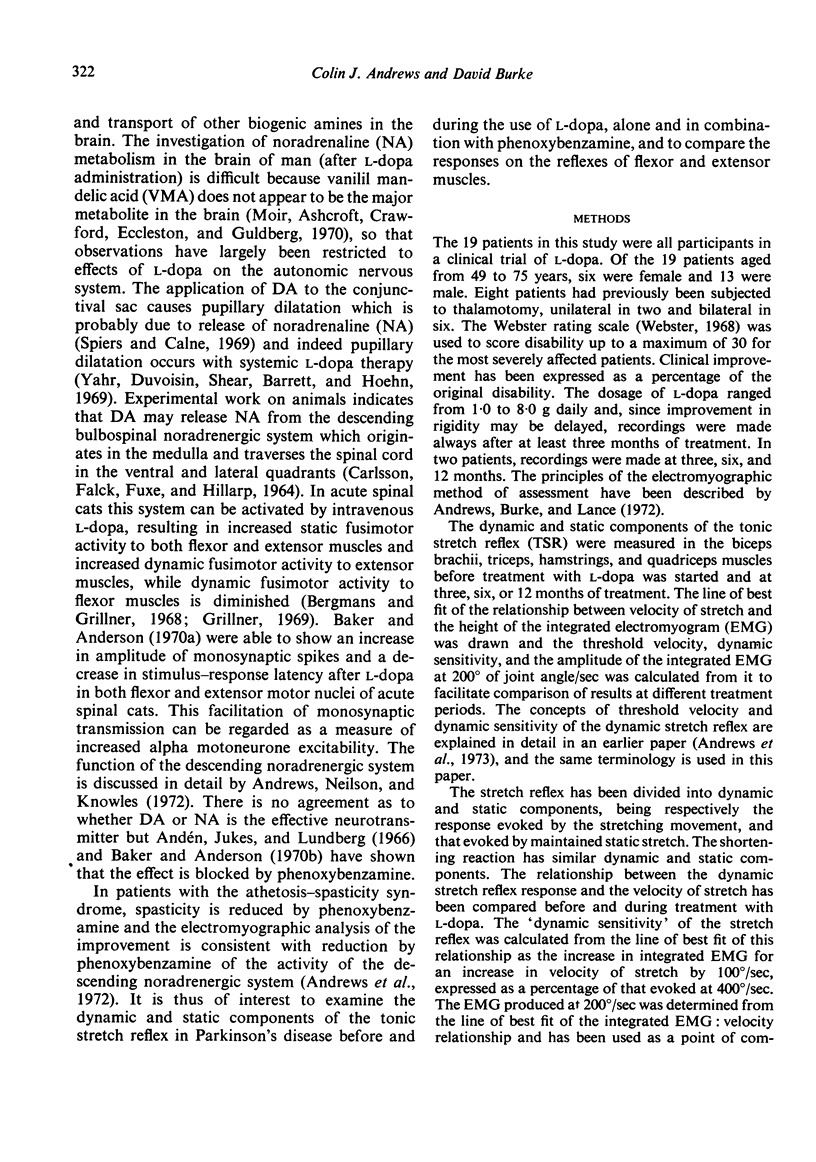Abstract
The static and dynamic components of the tonic stretch reflex and shortening reactions have been studied in biceps brachii, triceps, hamstrings, and quadriceps muscles of 19 patients with Parkinson's disease before and during L-dopa therapy. Clinical improvement during L-dopa administration correlated with a reduction in the dynamic component of the tonic stretch reflex in biceps, triceps, and quadriceps but not the hamstrings muscle, and with the static component of the tonic stretch reflex in biceps and triceps but not quadriceps and hamstrings muscles. The only shortening reaction consistently reduced during the L-dopa treatment period was the dynamic shortening reaction of the triceps muscle. The responses of the stretch reflexes to changes in muscle length were not altered by L-dopa therapy. In severely disabled patients the hamstrings and quadriceps stretch reflexes were maximal in a position of partial flexion of the knee joint and this response to muscle length was not altered in these patients despite a dramatic lessening of rigidity in some patients. Shortening reactions commonly remained in some patients after the stretch reflex of the antagonistic muscle was abolished by L-dopa therapy. The administration of phenoxybenzamine to patients being treated with L-dopa reduced the different components of rigidity more than L-dopa alone, and the responses were consistent with phenoxybenzamine suppressing predominantly the descending noradrenergic pathway.
Full text
PDF







Selected References
These references are in PubMed. This may not be the complete list of references from this article.
- ANDEN N. E., CARLSSON A., DAHLSTROEM A., FUXE K., HILLARP N. A., LARSSON K. DEMONSTRATION AND MAPPING OUT OF NIGRO-NEOSTRIATAL DOPAMINE NEURONS. Life Sci. 1964 Jun;3:523–530. doi: 10.1016/0024-3205(64)90161-4. [DOI] [PubMed] [Google Scholar]
- Andrews C. J., Neilson P., Knowles L. Electromyographic study of the rigidospasticity of athetosis. J Neurol Neurosurg Psychiatry. 1973 Feb;36(1):94–103. doi: 10.1136/jnnp.36.1.94. [DOI] [PMC free article] [PubMed] [Google Scholar]
- Andén N. E., Jukes M. G., Lundberg A. The effect of DOPA on the spinal cord. 2. A pharmacological analysis. Acta Physiol Scand. 1966 Jul-Aug;67(3):387–397. doi: 10.1111/j.1748-1716.1966.tb03325.x. [DOI] [PubMed] [Google Scholar]
- Baker R. G., Anderson E. G. The antagonism of the effects of L-3,4-dihydroxyphenylalanine of spinal reflexes by adrenergic blocking agents. J Pharmacol Exp Ther. 1970 May;173(1):224–231. [PubMed] [Google Scholar]
- Baker R. G., Anderson E. G. The effects of L-3,4-dihydroxyphenylalanine on spinal reflex activity. J Pharmacol Exp Ther. 1970 May;173(1):212–223. [PubMed] [Google Scholar]
- Bergmans J., Grillner S. Changes in dynamic sensitivity of primary endings of muscle spindle afferents induced by DOPA. Acta Physiol Scand. 1968 Dec;74(4):629–636. doi: 10.1111/j.1748-1716.1968.tb04273.x. [DOI] [PubMed] [Google Scholar]
- CARLSSON A., FALCK B., FUXE K., HILLARP N. A. CELLULAR LOCALIZATION OF MONOAMINES IN THE SPINAL CORD. Acta Physiol Scand. 1964 Jan-Feb;60:112–119. doi: 10.1111/j.1748-1716.1964.tb02874.x. [DOI] [PubMed] [Google Scholar]
- Chase T. N. 5-hydroxytryptophan in parkinsonism. Lancet. 1970 Nov 14;2(7681):1029–1030. doi: 10.1016/s0140-6736(70)92837-0. [DOI] [PubMed] [Google Scholar]
- Connor J. D. Caudate nucleus neurones: correlation of the effects of substantia nigra stimulaton with iontophoretic dopamine. J Physiol. 1970 Jul;208(3):691–703. doi: 10.1113/jphysiol.1970.sp009143. [DOI] [PMC free article] [PubMed] [Google Scholar]
- Connor J. D. Caudate unit responses to nigral stimuli: evidence for a possible nigro-neostriatal pathway. Science. 1968 May 24;160(3830):899–900. doi: 10.1126/science.160.3830.899. [DOI] [PubMed] [Google Scholar]
- Dietrichson P. Phasic ankle reflex in spasticity and Parkinsonian rigidity. The role of the fusimotor system. Acta Neurol Scand. 1971;47(1):22–51. doi: 10.1111/j.1600-0404.1971.tb07462.x. [DOI] [PubMed] [Google Scholar]
- EHRINGER H., HORNYKIEWICZ O. [Distribution of noradrenaline and dopamine (3-hydroxytyramine) in the human brain and their behavior in diseases of the extrapyramidal system]. Klin Wochenschr. 1960 Dec 15;38:1236–1239. doi: 10.1007/BF01485901. [DOI] [PubMed] [Google Scholar]
- Grillner S. The influence of DOPA on the static and the dynamic fusimotor activity to the triceps surae of the spinal cat. Acta Physiol Scand. 1969 Dec;77(4):490–509. doi: 10.1111/j.1748-1716.1969.tb04592.x. [DOI] [PubMed] [Google Scholar]
- Hagbarth K. E., Hongell A., Wallin G. Parkinson's disease: afferent muscle nerve activity in rigid patients. A preliminary report. Acta Soc Med Ups. 1970;75(1-2):70–76. [PubMed] [Google Scholar]
- Hidaka H. Fusaric (5-butylpicolinic) acid, an inhibitor of dopamine beta-hydroxylase, affects serotonin and noradrenaline. Nature. 1971 May 7;231(5297):54–55. doi: 10.1038/231054a0. [DOI] [PubMed] [Google Scholar]
- McLennan H. The release of dopamine from the putamen. Experientia. 1965 Dec 15;21(12):725–726. doi: 10.1007/BF02138500. [DOI] [PubMed] [Google Scholar]
- McLennan H., York D. H. The action of dopamine on neurones of the caudate nucleus. J Physiol. 1967 Apr;189(3):393–402. doi: 10.1113/jphysiol.1967.sp008175. [DOI] [PMC free article] [PubMed] [Google Scholar]
- Moir A. T., Ashcroft G. W., Crawford T. B., Eccleston D., Guldberg H. C. Cerebral metabolites in cerebrospinal fluid as a biochemical approach to the brain. Brain. 1970;93(2):357–368. doi: 10.1093/brain/93.2.357. [DOI] [PubMed] [Google Scholar]
- POIRIER L. J., SOURKES T. L. INFLUENCE OF THE SUBSTANTIA NIGRA ON THE CATECHOLAMINE CONTENT OF THE STRIATUM. Brain. 1965 Mar;88:181–192. doi: 10.1093/brain/88.1.181. [DOI] [PubMed] [Google Scholar]
- Portig P. J., Vogt M. Release to the cerebral ventricles of substances with possible transmitter function in the caudate nucleus. J Physiol. 1969 Oct;204(3):687–715. doi: 10.1113/jphysiol.1969.sp008939. [DOI] [PMC free article] [PubMed] [Google Scholar]
- RUSHWORTH G. The gamma system in parkinsonism. Int J Neurol. 1961;2:34–50. [PubMed] [Google Scholar]
- Reis D. J., Moorhead D. T., 2nd, Merlino N. Dopa-induced excitement in the cat. Its relationship to brain norepinephrine concentrations. Arch Neurol. 1970 Jan;22(1):31–39. doi: 10.1001/archneur.1970.00480190035006. [DOI] [PubMed] [Google Scholar]
- Spiers A. S., Calne D. B. Action of dopamine on the human iris. Br Med J. 1969 Nov 8;4(5679):333–335. doi: 10.1136/bmj.4.5679.333. [DOI] [PMC free article] [PubMed] [Google Scholar]
- Ungerstedt U. Stereotaxic mapping of the monoamine pathways in the rat brain. Acta Physiol Scand Suppl. 1971;367:1–48. doi: 10.1111/j.1365-201x.1971.tb10998.x. [DOI] [PubMed] [Google Scholar]
- Webster D. D. Critical analysis of the disability in Parkinson's disease. Mod Treat. 1968 Mar;5(2):257–282. [PubMed] [Google Scholar]
- Yahr M. D., Duvoisin R. C., Schear M. J., Barrett R. E., Hoehn M. M. Treatment of parkinsonism with levodopa. Arch Neurol. 1969 Oct;21(4):343–354. doi: 10.1001/archneur.1969.00480160015001. [DOI] [PubMed] [Google Scholar]
- Yap C. B. Spinal segmental and long-loop reflexes on spinal motoneurone excitability in spasticity and rigidity. Brain. 1967 Dec;90(4):887–896. doi: 10.1093/brain/90.4.887. [DOI] [PubMed] [Google Scholar]


